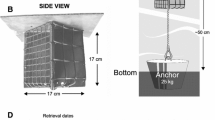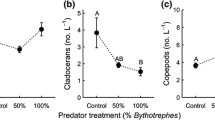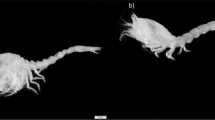Abstract
Introduced species are having major impacts in terrestrial, freshwater and marine ecosystems world-wide. It is increasingly recognised that effects of multiple species often cannot be predicted from the effect of each species alone, due to complex interactions, but most investigations of invasion impacts have examined only one non-native species at a time and have not addressed the interactive effects of multiple species. We conducted a field experiment to compare the individual and combined effects of two introduced marine predators, the northern Pacific seastar Asterias amurensis and the European green crab Carcinus maenas, on a soft-sediment invertebrate assemblage in Tasmania. Spatial overlap in the distribution of these invaders is just beginning in Tasmania, and appears imminent as their respective ranges expand, suggesting a strong overlap in food resources will result from the shared proclivity for bivalve prey. A. amurensis and C. maenas provide good models to test the interaction between multiple introduced predators, because they leave clear predator-specific traces of their predatory activity for a number of common prey taxa (bivalves and gastropods). Our experiments demonstrate that both predators had a major effect on the abundance of bivalves, reducing populations of the commercial bivalves Fulvia tenuicostata and Katelysia rhytiphora. The interaction between C. maenas and A. amurensis appears to be one of resource competition, resulting in partitioning of bivalves according to size between predators, with A. amurensis consuming the large and C. maenas the small bivalves. At a large spatial scale, we predict that the combined effect on bivalves may be greater than that due to each predator alone simply because their combined distribution is likely to cover a broader range of habitats. At a smaller scale, in the shallow subtidal, where spatial overlap is expected to be most extensive, our results indicate the individual effects of each predator are likely to be modified in the presence of the other as densities increase. These results further highlight the need to consider the interactive effects of introduced species, especially with continued increases in the number of established invasions.




Similar content being viewed by others
References
Buchanan JB (1966) The biology of Echinocardium cordatum (Echinodermata: Spatangoidea) from different habitats. J Mar Biol Assoc UK 46:97–114
Carlton JT (1999) A journal of biological invasions. Biol Invasions 1:1
Carlton JT, Geller JB (1993) Ecological roulette: the global transport of nonindigenous marine organisms. Science 261:78–82
Clarke KR (1993) Non-parametric multivariate analysis of changes in community structure. Aust J Ecol 18:117–143
Cloern JE (1996) Phytoplankton bloom dynamics in coastal ecosystems: a review with some general lessons from sustained investigations of San Francisco Bay, California. Rev Geophysics 34:127–168
Cohen AN, Carlton JT (1998) Accelerating invasion rate in a highly invaded estuary. Science 279:555–558
Crothers JH (1968) The biology of the shore crab Carcinus maenas (L). 2. The life of the adult crab. Field Stud 2:579–614
D’Antonio CM, Hughes RF, Mack M, Hitchcock D, Vitousek PM (1998) The response of native species to removal of invasive exotic grasses in a seasonally dry Hawaiian woodland. J Veg Sci 9:699–712
Draper NR, Smith H (1981) Applied regression analysis. Wiley, New York
Fukuyama AK (1994) A review of the distribution and life history of Asterias amurensis on the northeast Pacific coast. Report to CSIRO, Hobart and National Seastar Task Force. Fukuyama-Hironaka Taxonomic and Environmental Services, Washington, USA
Fukuyama AK, Oliver JS (1985) Sea star and walrus predation on bivalves in Morton Sound, Bering Sea, Alaska. Ophelia 24:17–36
Fulton SW, Grant FE (1900) Note on the occurrence of the European crab, Carcinus maenas, Leach, in Port Phillip. Vic Nat 17:145–146
Furlani DM (1996) A guide to the introduced marine species in Australian waters. Centre for Research on Introduced Marine Pests, CSIRO, Division of Fisheries, Hobart, Australia
Gardner NC, Kwa S, Paturusi A (1994) First recording of the European shore crab Carcinus maenas in Tasmania. Tasman Nat 116:26–28
Grannum RK, Murfet NB, Ritz DA, Turner E (1996) The distribution and impact of the exotic seastar, Asterias amurensis (Lütken), in Tasmania. In: The introduced northern Pacific seastar, Asterias amurensis, in Tasmania. Australian Nature Conservation Agency, Canberra, Australia, pp 53–135
Griffiths CL, Hockey PAR, Schurink CV, Roux PJL (1992) Marine invasive aliens on South African shores: implication for community structure and trophic functioning. S Afr J Mar Sci 12:713–722
Grosholz ED, Ruiz GM (1995) Spread and potential impact of the recently introduced European green crab, Carcinus maenas, in central California. Mar Biol 122:239–247
Grosholz ED, Ruiz GM, Dean CA, Shirley KA, Maron JL, Connors PG (2000) The impacts of a nonindigenous marine predator in a California bay. Ecology 81:1206–1224
Hatanaka M, Kosaka M (1959) Biological studies on the population of the starfish, Asterias amurensis, in Sendai Bay. Tohoku J Agric Res 9:159–178
Hewitt CL, Campbell ML, Thresher RE, Martin RB (1999) The introduced species of Port Phillip Bay, Victoria. CSIRO Marine Research, Hobart, Australia
Hulberg LW, Oliver JS (1980) Caging manipulations in marine soft-sediment bottom communities, importance of animal interactions or sedimentary habitat modifications. Can J Fish Aquat Sci 37:1130–1139
Jensen KT, Jensen JN (1985) The importance of some epibenthic predators on the density of juvenile benthic macrofauna in the Danish Wadden Sea. J Exp Mar Biol Ecol 89:157–174
Jones MM (1991) Marine organisms transported in ballast water: a review of the Australian scientific position. Department of Primary Industries and Energy, Bureau of Rural Resources, AGPS, Canberra, Australia
Kareiva P (1994) Higher order interactions as a foil to reductionist ecology. Ecology 75:1527–1528
Kim YS (1969) Selective feeding on the several bivalve molluscs by starfish, Asterias amurensis Lüken. Bull Fac Fish Hokkaido Univ 19:244–249
Ling SD (2000) The effect of anthropogenic structures on the reproductive output of the northern Pacific seastar Asterias amurensis in the Derwent Estuary. Honours thesis, University of Tasmania, Hobart, Australia
Lockhart SJ (1995) Feeding biology of the introduced sea star, Asterias amurensis (Lütken) in Tasmania (Echinodermata Asteroidea). Honours thesis, University of Tasmania, Hobart, Australia
Mascaró M, Seed R (2000) Foraging behavior of Carcinus maenas (L.): comparisons of size-selective predation on four species of bivalve prey. J Shellfish Res 19:283–291
McKinnon CJ (1997) Impact of the introduced European green crab, Carcinus maenas, on Tasmanian bivalve populations. Honours thesis, University of Tasmania, Hobart, Australia
Morrice MG (1995) The distribution and ecology of the introduced northern Pacific seastar, Asterias amurensis (Lütken), in Tasmania. In: The introduced northern Pacific seastar, Asterias amurensis, in Tasmania. Australian Nature Conservation Agency, Canberra, Australia, pp 1–47
Newman JA, Bergelson J, Grafen AG (1997) Blocking factors and hypothesis tests in ecology: is your statistics text wrong? Ecology 78:1312–1320
Nojima S, Soliman FA, Kondo Y, Kuwano Y, Nasu K, Kitajima C (1986) Some notes of the outbreak of the sea star Asterias amurensis versiclor Sladen, in the Ariake Sea, western Kyshu. Publ Amakusa Mar Biol Lab Kyushu Univ 8:89–112
Peterson CH (1979) Predation, competitive exclusion, and diversity in soft-sediment benthic communities in estuaries and lagoons. In: Livingston RJ (ed) Ecological processes in coastal and marine systems. Plenum, New York, pp 233–264
Pollard DA, Hutchings PA (1990a) A review of exotic marine organisms introduced to the Australian region. I. Fishes. Asian Fish Sci 3:205–221
Pollard DA, Hutchings PA (1990b) A review of exotic marine organisms introduced to the Australian region. 2. Invertebrates and algae. Asian Fish Sci 3:222–250
Quinn GP, Keough MJ (2003) Experimental design and data analysis for biologists. Cambridge University Press, Cambridge
Reise K (1985) Tidal flat ecology: an experimental approach to species interactions. Springer, Berlin New York Heidelberg
Ropes JW (1968) The feeding habits of the green crab, Carcinus maenas (L.). Fish Bull (Wash DC) 67:183–203
Ross DJ, Johnson CR, Hewitt CL (2002) Impact of introduced seastars Asterias amurensis on survivorship of juvenile commercial bivalves Fulvia tenuicostata. Mar Ecol Prog Ser 241:99–112
Ross DJ, Johnson CR, Hewitt CL (2003a) Variability in the impact of an introduced predator (Asterias amurensis: Asteroidea) on soft-sediment assemblages. J Exp Mar Biol Ecol 288:257–278
Ross DJ, Johnson CR, Hewitt CL (2003b) Assessing the ecological impacts of an introduced seastar: the importance of multiple methods. Biol Invasions 5:3–21
Ruiz GM, Carlton JT (2003) Invasion vectors: a conceptual framework for management. In: Ruiz GM, Carlton JT (eds) Invasive species: vectors and management strategies. Island Press, Washington, USA (in press)
Ruiz GM, Fofonoff P, Hines AH (1999) Non-indigenous species as stressors in estuarine and marine communities: assessing invasion impacts and interactions. Limnol Oceanogr 44:950–972
Ruiz GM, Fofonoff P, Carlton JT, Wonham MJ, Hines AH (2000) Invasions of coastal marine communities in North America: apparent patterns, processes and biases. Annu Rev Ecol Syst 31:481–531
Sanchez-Salazar ME, Griffiths CL, Seed R (1987) The interactive roles of predation and tidal elevation in structuring populations of the edible cockle, Cerastoderma edule. Estuar Coast Shelf Sci 25:245–260
Simberloff D, von Holle B (1999) Positive interaction of nonindigenous species: invasional meltdown? Biol Invasions 1:21–32
Strayer DL, Caraco NF, Cole JJ, Findlay S, Pace ML (1999) Transformation of freshwater ecosystems by bivalves: a case study of zebra mussels in the Hudson River. BioScience 48:19–28
Thresher R, Proctor C, Ruiz G, Gurney R, MacKinnon C, Walton W, Rodriguez L, Bax N (2003) Invasion dynamics of the European green crab, Carcinus maenas, in Australia. Mar Ecol Prog Ser 142:867–876
Thrush SF (1999) Complex role of predators in structuring soft-sediment macrobenthic communities: implications of changes in spatial scale for experimental studies. Aust J Ecol 24:344–354
Underwood AJ (1986) The analysis of competition by field experiments. In: Anderson DJ, Kikkawa J (eds) Community ecology: pattern and process. Blackwell, Oxford, pp 240–268
Vitousek PM (1994) Beyond global warming—ecology and global change. Ecology 75:1861–1876
Vitousek PM, D’Antonio CM, Loope LL, Westbrooks R (1996) Biological invasions as global environmental change. Am Sci 84:468–478
Walne PR, Dean GJ (1972) Experiments on predation by the shore crab, Carcinus maenas L., on Mytilus and Mercenaria. J Con Int Explor Mer 34:190–199
Walton WC (2003) Ecology of invasive populations of the European green crab Carcinus maenas. PhD dissertation, University of Maryland, College Park, USA
Walton WC, MacKinnon C, Rodriguez LF, Proctor C, Ruiz GM (2002) Effect of an invasive crab upon a marine fishery: green crab, Carcinus maenas, predation upon a venerid clam, Katelysia scalarina, in Tasmania (Australia). J Exp Mar Biol Ecol 272:171–189
Wilcove DS, Dubow J, Phillips A, Losos E (1998) Quantifying threats to imperilled species in the United States. BioScience 48:607–616
Acknowledgements
We thank the many volunteers and co-workers who braved the cold waters of King George Sound, without whose help this project would not have been possible, particularly N. Murfet and P. Dunstan. Special thanks go to S. Scott for her tireless hours of sorting samples and L. Turner, G. Edgar and C. Macleod for help with the identification of invertebrates. This manuscript benefited from discussions with and comments from R. Thresher and C. Procter. This work was supported by funds from the CSIRO Marine Research Centre for Research on Introduced Marine Pests (awarded to C.R.J.) and the School of Zoology, University of Tasmania. This work was undertaken as part the senior author’s Doctor of Philosophy degree at the University of Tasmania, who was supported by an Australian Postgraduate Award. The experiments we performed comply with the current laws of Australia, conducted on a permit for introduced species research issued under section 14 of the Living Marine Resources Management Act 1995 in Tasmania.
Author information
Authors and Affiliations
Corresponding author
Additional information
Communicated by M.S. Johnson, Crawley
Rights and permissions
About this article
Cite this article
Ross, D.J., Johnson, C.R., Hewitt, C.L. et al. Interaction and impacts of two introduced species on a soft-sediment marine assemblage in SE Tasmania. Marine Biology 144, 747–756 (2004). https://doi.org/10.1007/s00227-003-1223-4
Received:
Accepted:
Published:
Issue Date:
DOI: https://doi.org/10.1007/s00227-003-1223-4




